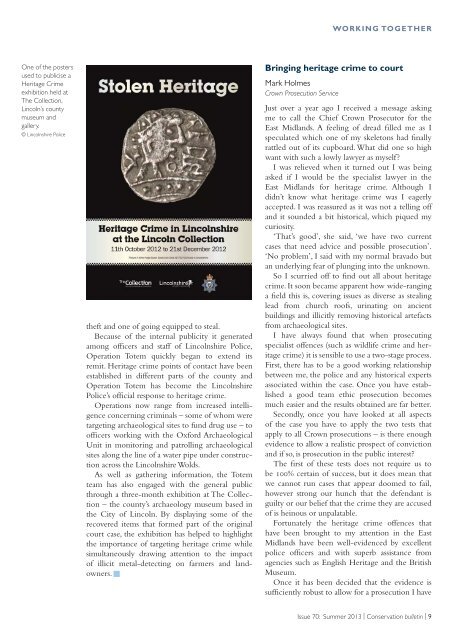Conservation Bulletin 70 | PDF - English Heritage
Conservation Bulletin 70 | PDF - English Heritage
Conservation Bulletin 70 | PDF - English Heritage
Create successful ePaper yourself
Turn your PDF publications into a flip-book with our unique Google optimized e-Paper software.
WORKING TOGETHER<br />
One of the posters<br />
used to publicise a<br />
<strong>Heritage</strong> Crime<br />
exhibition held at<br />
The Collection,<br />
Lincoln’s county<br />
museum and<br />
gallery.<br />
© Lincolnshire Police<br />
theft and one of going equipped to steal.<br />
Because of the internal publicity it generated<br />
among officers and staff of Lincolnshire Police,<br />
Operation Totem quickly began to extend its<br />
remit. <strong>Heritage</strong> crime points of contact have been<br />
established in different parts of the county and<br />
Operation Totem has become the Lincolnshire<br />
Police’s official response to heritage crime.<br />
Operations now range from increased intelligence<br />
concerning criminals – some of whom were<br />
targeting archaeological sites to fund drug use – to<br />
officers working with the Oxford Archaeological<br />
Unit in monitoring and patrolling archaeological<br />
sites along the line of a water pipe under construction<br />
across the Lincolnshire Wolds.<br />
As well as gathering information, the Totem<br />
team has also engaged with the general public<br />
through a three-month exhibition at The Collection<br />
– the county’s archaeology museum based in<br />
the City of Lincoln. By displaying some of the<br />
recovered items that formed part of the original<br />
court case, the exhibition has helped to highlight<br />
the importance of targeting heritage crime while<br />
simultaneously drawing attention to the impact<br />
of illicit metal-detecting on farmers and landowners.<br />
■<br />
Bringing heritage crime to court<br />
Mark Holmes<br />
Crown Prosecution Service<br />
Just over a year ago I received a message asking<br />
me to call the Chief Crown Prosecutor for the<br />
East Midlands. A feeling of dread filled me as I<br />
speculated which one of my skeletons had finally<br />
rattled out of its cupboard.What did one so high<br />
want with such a lowly lawyer as myself?<br />
I was relieved when it turned out I was being<br />
asked if I would be the specialist lawyer in the<br />
East Midlands for heritage crime. Although I<br />
didn’t know what heritage crime was I eagerly<br />
accepted. I was reassured as it was not a telling off<br />
and it sounded a bit historical, which piqued my<br />
curiosity.<br />
‘That’s good’, she said, ‘we have two current<br />
cases that need advice and possible prosecution’.<br />
‘No problem’, I said with my normal bravado but<br />
an underlying fear of plunging into the unknown.<br />
So I scurried off to find out all about heritage<br />
crime. It soon became apparent how wide-ranging<br />
a field this is, covering issues as diverse as stealing<br />
lead from church roofs, urinating on ancient<br />
buildings and illicitly removing historical artefacts<br />
from archaeological sites.<br />
I have always found that when prosecuting<br />
specialist offences (such as wildlife crime and heritage<br />
crime) it is sensible to use a two-stage process.<br />
First, there has to be a good working relationship<br />
between me, the police and any historical experts<br />
associated within the case. Once you have established<br />
a good team ethic prosecution becomes<br />
much easier and the results obtained are far better.<br />
Secondly, once you have looked at all aspects<br />
of the case you have to apply the two tests that<br />
apply to all Crown prosecutions – is there enough<br />
evidence to allow a realistic prospect of conviction<br />
and if so, is prosecution in the public interest?<br />
The first of these tests does not require us to<br />
be 100% certain of success, but it does mean that<br />
we cannot run cases that appear doomed to fail,<br />
however strong our hunch that the defendant is<br />
guilty or our belief that the crime they are accused<br />
of is heinous or unpalatable.<br />
Fortunately the heritage crime offences that<br />
have been brought to my attention in the East<br />
Midlands have been well-evidenced by excellent<br />
police officers and with superb assistance from<br />
agencies such as <strong>English</strong> <strong>Heritage</strong> and the British<br />
Museum.<br />
Once it has been decided that the evidence is<br />
sufficiently robust to allow for a prosecution I have<br />
Issue <strong>70</strong>: Summer 2013 | <strong>Conservation</strong> bulletin | 9

















